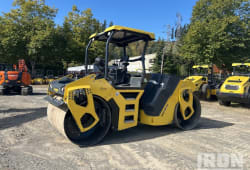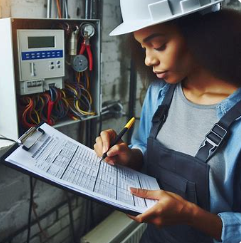Working at Heights: Risks and Precautions for Heavy Equipment Operators
13 Lectura mínima
)
agosto 11, 2023
Working at heights can be dangerous, especially for heavy equipment operators. This article will explore the risks associated with working at heights and the precautions that heavy equipment operators should take to ensure their safety.
Understanding the Risks of Working at Heights
Working at heights presents a unique set of risks that operators need to be aware of. The primary risk is the potential for falls, which can result in severe injuries or even fatalities. In addition to falls, there are other height-related risks that operators should be mindful of.
When working at heights, operators are exposed to various hazards such as unstable platforms, slippery surfaces, and unpredictable weather conditions. These factors increase the likelihood of accidents and injuries. Additionally, the use of heavy equipment adds another layer of complexity and potential risks.
Unstable platforms can be a major concern when working at heights. Whether it's a scaffold, elevated work platform, or ladder, the stability of the structure is crucial. Even a slight shift or wobble can lead to a loss of balance and a dangerous fall. Operators must ensure that platforms are properly secured and regularly inspected for any signs of weakness or deterioration.
Slippery surfaces can also pose a significant risk when working at heights. Rain, snow, or even just a thin layer of dust can make surfaces slippery and increase the chances of a fall. It's important for operators to use appropriate footwear with good traction and to take extra precautions when working in wet or icy conditions.
Weather conditions can be highly unpredictable, especially when working at great heights. Strong winds, sudden storms, or extreme temperatures can make the work environment even more hazardous. Operators need to stay informed about weather forecasts and be prepared to postpone work if conditions become too dangerous.
The use of heavy equipment adds another layer of complexity and potential risks when working at heights. Cranes, aerial lifts, and other machinery can malfunction or fail, leading to accidents and injuries. Operators must be properly trained in the use of such equipment and conduct regular inspections to ensure their safe operation.
Accidents at heights can lead to a range of injuries, including fractures, concussions, and spinal cord injuries. Some of the most common accidents involve falls from elevated work platforms, scaffolding collapses, and equipment malfunction. Operators must understand these risks and take appropriate precautions to mitigate them.
Working at heights requires constant vigilance and adherence to safety protocols. Operators must be aware of the potential risks and take proactive measures to ensure their safety and the safety of those around them. By understanding the nature of height-related risks and implementing effective safety measures, operators can minimize the chances of accidents and injuries in the workplace.
The Role of Heavy Equipment in Height-Related Work
Heavy equipment plays a vital role in executing tasks at heights efficiently. Whether it's constructing towering skyscrapers or maintaining power lines, the use of heavy equipment is essential in completing these challenging jobs. However, it also introduces specific risks that operators must be aware of to ensure their safety and the safety of others.
When it comes to working at heights, various types of heavy equipment are commonly used. These include cranes, aerial lifts, and scaffolding. Each type of equipment presents its own set of risks and considerations that operators must take into account to carry out their work effectively and safely.
Types of Heavy Equipment Used at Heights
Crane operators are responsible for operating towering machines that are capable of lifting heavy loads to great heights. The stability of the crane and its lifting capacity are critical factors that operators need to carefully assess before initiating any lifting operation. They must also consider factors such as wind speed and the weight distribution of the load to ensure a stable and secure lift.
Aerial lifts, also known as cherry pickers or boom lifts, are another type of heavy equipment commonly used at heights. These machines provide a platform for workers to access elevated areas safely. However, aerial lift operators must ensure the proper operation of controls and safety harnesses to prevent accidents. They must also be mindful of obstacles such as power lines or trees that may pose a threat to their safety.
Scaffolding is a temporary structure that provides a platform for workers to perform tasks at heights. It is commonly used in construction projects and allows workers to move freely while working on different levels. However, scaffolding users need to assess its stability and ensure that it is properly erected and secured. Regular inspections and maintenance are crucial to prevent any potential collapses or accidents.
Specific Risks Associated with Different Heavy Equipment
Depending on the equipment being used, operators face unique risks that require their utmost attention and caution. For instance, crane operators must be cautious of potential swinging loads that can cause serious injuries or damage to surrounding structures. They must also be aware of the risks associated with operating cranes in high winds, as strong gusts can affect the stability and control of the crane.
Aerial lift operators, on the other hand, must be mindful of the risks of working at heights, such as falls or being struck by falling objects. Proper training and adherence to safety protocols are crucial to minimize these risks. Additionally, operators must be aware of the specific limitations of the aerial lift they are using, such as its maximum weight capacity and height restrictions.
For those working on scaffolding, the stability of the structure is of utmost importance. Scaffolding must be erected by trained professionals and regularly inspected to ensure that it can support the weight of workers and materials. Workers must also be cautious of potential hazards such as slippery surfaces or loose guardrails that can lead to falls or other accidents.
Understanding these risks enables operators to take appropriate safety measures and reduce the likelihood of accidents. This includes undergoing proper training, following safety guidelines, and conducting regular inspections of the equipment. By prioritizing safety and being vigilant, operators can confidently carry out their work at heights using heavy equipment, ensuring the successful completion of projects while keeping themselves and others safe.
Safety Measures and Precautions for Working at Heights
Implementing safety measures and precautions is crucial to prevent accidents and protect operators when working at heights. Whether it's construction workers on a high-rise building or technicians repairing power lines, following proper safety guidelines is paramount.
One of the most important aspects of working at heights is the use of Personal Protective Equipment (PPE). When working at heights, operators must use appropriate PPE to ensure their safety. This may include helmets, safety harnesses, non-slip footwear, and high-visibility clothing. These items not only protect against potential falls but also provide an extra layer of protection in case of other accidents.
Additionally, operators need to receive proper training on the safe operation of heavy equipment at heights. This training should cover various topics such as equipment inspection, safety protocols, and emergency procedures. By ensuring that operators are well-trained, the risk of accidents can be significantly reduced.
Regular maintenance and inspections of equipment are also crucial when working at heights. Heavy equipment used at heights must be regularly checked for any signs of wear and tear or malfunction. This includes inspecting cables, ropes, and other components to ensure their integrity. By conducting regular maintenance and inspections, operators can ensure the safe and efficient operation of the equipment.
Furthermore, it is important to consider environmental factors when working at heights. Weather conditions such as strong winds, rain, or extreme temperatures can pose additional risks. Operators should be aware of these factors and take appropriate precautions to mitigate any potential hazards.
Another aspect to consider is the importance of communication and teamwork when working at heights. Clear communication between operators and their team members is crucial to ensure everyone's safety. This includes using hand signals, radios, or other communication devices to relay important information and coordinate tasks.
In conclusion, working at heights requires careful planning, adherence to safety measures, and continuous vigilance. By using proper PPE, receiving adequate training, conducting regular equipment maintenance, considering environmental factors, and promoting effective communication and teamwork, operators can minimize the risk of accidents and ensure a safe working environment.
Legal and Regulatory Considerations for Working at Heights
Working at heights can be a challenging task that requires heavy equipment operators to adhere to legal and regulatory requirements to maintain a safe work environment. In addition to the inherent risks associated with working at heights, there are various laws and guidelines in place to ensure the safety of workers in these situations.
Occupational Safety and Health Administration (OSHA) Standards
One of the key regulatory bodies that heavy equipment operators need to be aware of is the Occupational Safety and Health Administration (OSHA). OSHA provides guidelines and sets standards that aim to protect workers' safety when working at heights. These standards cover a wide range of topics, including fall protection, equipment inspection, and training requirements.
When it comes to fall protection, OSHA requires employers to provide fall protection systems for workers who are working at heights of six feet or more. This can include guardrails, safety nets, or personal fall arrest systems. Regular inspection of these fall protection systems is also required to ensure their effectiveness and reliability.
In terms of equipment inspection, OSHA mandates that employers must ensure that all equipment used for working at heights is inspected regularly. This includes inspecting ladders, scaffolds, and other elevated platforms for any signs of damage or wear and tear that could compromise their safety. Any defective equipment should be immediately repaired or replaced to prevent accidents or injuries.
Furthermore, OSHA emphasizes the importance of providing adequate training to workers who are involved in working at heights. Employers are responsible for ensuring that their employees receive proper training on the safe use of equipment, recognizing potential hazards, and following safety protocols. Regular refresher training should also be conducted to keep workers up to date with the latest safety practices.
Employer Responsibilities and Worker Rights
Employers play a crucial role in ensuring the safety of their workers when working at heights. They have a legal responsibility to provide a safe working environment, which includes implementing safety protocols, providing appropriate safety equipment, and offering comprehensive training programs.
Employers should conduct thorough risk assessments to identify potential hazards and implement control measures to minimize the risk of accidents. This can involve developing safe work procedures, establishing emergency response plans, and ensuring that workers have access to the necessary safety equipment, such as harnesses, helmets, and safety goggles.
Workers also have certain rights when it comes to working at heights. They have the right to refuse work if they believe it puts their safety at risk. Employers cannot retaliate against employees who exercise this right, and they must address any concerns raised by workers regarding safety hazards or inadequate safety measures. This encourages open communication between employers and employees, fostering a safer work environment.
In conclusion, working at heights requires heavy equipment operators to comply with legal and regulatory requirements to ensure the safety of themselves and their coworkers. By familiarizing themselves with OSHA standards, understanding employer responsibilities, and exercising worker rights, operators can contribute to a safer work environment and prevent accidents or injuries.
Training and Education for Height Safety
Proper training and education are crucial in mitigating the risks associated with working at heights. Working at heights poses significant dangers, including falls, equipment malfunctions, and hazardous weather conditions. Therefore, operators need to undergo rigorous training to ensure their safety and the safety of those around them.
Training programs play a vital role in equipping operators with the knowledge and skills necessary to work safely at heights. These programs should cover topics such as hazard identification, equipment operation, and emergency response. By investing in comprehensive training, operators can reduce the likelihood of accidents and injuries.
One aspect of training that should not be overlooked is the importance of proper equipment usage. Operators must be trained on how to inspect, maintain, and correctly use safety harnesses, lanyards, and other fall protection equipment. This knowledge is critical in ensuring that operators are adequately protected while working at heights.
Importance of Proper Training in Risk Mitigation
Proper training is essential in mitigating the risks associated with working at heights. A well-trained operator will not only be able to identify potential hazards but also know how to address them effectively. They will understand the importance of following safety protocols and be equipped with the necessary skills to do so.
Furthermore, training programs provide operators with valuable knowledge about emergency response procedures. In the event of an accident or unforeseen circumstances, operators who have received proper training will be better equipped to handle the situation. This can significantly reduce the severity of injuries and potentially save lives.
Recommended Training Programs for Heavy Equipment Operators
There are various training programs available for heavy equipment operators working at heights. These programs should align with industry best practices and cover the specific equipment and tasks relevant to the operator's role. It is essential to select reputable training providers to ensure the quality and effectiveness of the programs.
One recommended training program for heavy equipment operators is the "Height Safety Certification" course. This comprehensive program covers a wide range of topics, including risk assessment, fall prevention, and emergency rescue techniques. The course is designed to provide operators with the necessary knowledge and skills to safely operate heavy equipment at heights.
Another valuable training program is the "Advanced Fall Protection Training" course. This program focuses specifically on fall protection systems and techniques. Operators will learn how to properly inspect and use personal fall arrest systems, as well as how to conduct rescue operations in the event of a fall.
Operators need to undergo periodic refresher training to ensure that their skills and knowledge remain up to date. With advancements in technology and changes in safety regulations, operators must stay informed and adapt their practices accordingly.
In conclusion, proper training and education are essential for operators working at heights. These programs provide operators with the necessary knowledge and skills to mitigate risks and ensure their safety. By investing in comprehensive training programs and selecting reputable providers, operators can confidently perform their duties and contribute to a safer working environment.
Case Studies of Accidents and Their Lessons
By analyzing past accidents, we can learn valuable lessons and identify preventive measures to improve safety.
Analysis of Past Accidents
Studying past accidents helps us understand the common causes and contributing factors. By identifying these patterns, operators and employers can take proactive steps to prevent similar incidents from occurring in the future.
Lessons Learned and Preventive Measures
Based on the analysis of past accidents, preventive measures can be implemented. This may include improving safety protocols, enhancing training programs, and conducting regular equipment inspections. Emphasizing the lessons learned from accidents can create a safer working environment for heavy equipment operators.
By following these precautions and implementing safety measures, heavy equipment operators can significantly reduce the risks associated with working at heights. Ultimately, prioritizing safety ensures the well-being of operators and promotes a culture of safety in the workplace.

Mike Kennedy is Boom & Bucket's Marketplace Operations Manager, where he leads shipping, warranties, and post-sale operations to create a seamless buyer experience. As one of the company's earliest team members, Mike helped build the foundation of Boom & Bucket's operations and guided its growth through acquisition by RB Global. He is passionate about scaling marketplaces, solving operational challenges, and improving efficiency to deliver industry-leading results.














